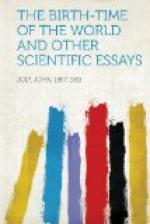It was in connection with photo-electric science that I was led to take an interest in the application of radioactivity in medicine. The lecture on The Use of Radium in Medicine deals with this subject. Towards the conclusion of this essay reference will be found to a practical outcome of such studies which, by improving on the methods, and facilitating the application, of radioactive treatment, has, in the hands of skilled medical men, already resulted in the alleviation of suffering.
Leaving out much which might well appear in a prefatory notice, a word should yet be added respecting the illustrations of scenery. They are a small selection from a considerable number of photographs taken during my summer wanderings in the Alps in company with Henry H. Dixon. An exception is Plate X, which is by the late Dr. Edward Stapleton. From what has been said above, it will be gathered that these illustrations are fitly included among pages which owe so much to Alpine inspiration. They illustrate the
xv
subjects dealt with, and, it is to be hoped, they will in some cases recall to the reader scenes which have in past times influenced his thoughts in the same manner; scenes which in their endless perspective seem to reduce to their proper insignificance the lesser things of life.
My thanks are due to Mr. John Murray for kindly consenting to the reissue of the essay on The Birth-time of the World from the pages of Science Progress; to Messrs. Constable & Co. for leave to reprint Pleochroic Haloes from Bedrock, and also to make some extracts from Radioactivity and Geology; and to the Council of the Royal Dublin Society for permission to republish certain papers from the Proceedings of the Society.
Iveagh Geological Laboratory, Trinity College, Dublin.
July, 1915.
xvi
THE BIRTH-TIME OF THE WORLD [1]
LONG ago Lucretius wrote: “For lack of power to solve the question troubles the mind with doubts, whether there was ever a birth-time of the world and whether likewise there is to be any end.” “And if” (he says in answer) “there was no birth-time of earth and heaven and they have been from everlasting, why before the Theban war and the destruction of Troy have not other poets as well sung other themes? Whither have so many deeds of men so often passed away, why live they nowhere embodied in lasting records of fame? The truth methinks is that the sum has but a recent date, and the nature of the world is new and has but lately had its commencement."[2]
Thus spake Lucretius nearly 2,000 years ago. Since then we have attained another standpoint and found very different limitations. To Lucretius the world commenced with man, and the answer he would give to his questions was in accord with his philosophy: he would date the birth-time of the world from the time when
[1] A lecture delivered before the Royal Dublin Society, February 6th, 1914. Science Progress, vol. ix., p. 37




